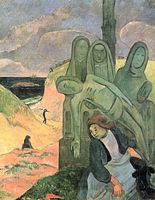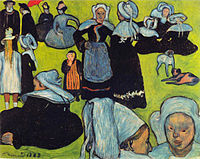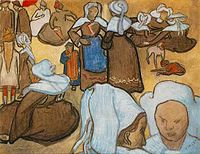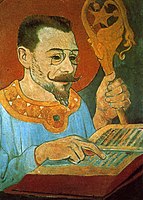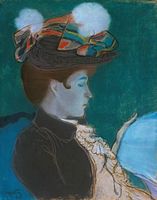綜合主義
来自维基百科,自由的百科全书
綜合主義(Synthetism),類似象徵主義的19世紀後印象派美術主義。

概述

綜合主義原本是一文學主義,其延伸至美術是因1889年,畫家高更自號為「綜合派畫家」,綜合主義才正式於美術風行。綜合主義發展初期,與分隔主義有很大關聯。後來才逐漸變得與象徵主義有關。綜合主義多使用特有的「隔色畫法」,並且旨在表達觀念、不同氣氛和起伏情感,為自然主義的對立主義。畫家繪畫技巧多為綜合不同印象和依組合其大腦中的記憶。因隔色畫法的關係,色彩多為明亮並以黑線隔開不同顏色,目的是完成抽象且綜合的作品。[1]
綜合主義畫家的特色
代表美術家

活躍於19世紀80至90年代
畫廊
-
保羅·高更, Vision after the Sermon, 1888.
-
保羅·塞律西埃, The Talisman (with the forest landscape of love in Pont-Aven) 1888
-
保羅·高更, The Green Christ, 1889
-
埃米爾·貝納, Breton Women in the Meadow, August 1888. Bernard exchanged this one with Gauguin who brought it to Arles in autumn 1888 when he joined Van Gogh, who was totally fond of this style. Van Gogh painted a copy in watercolor to inform his brother Theo about it.
-
梵高, Breton Women and Children, November 1888 (watercolor after Bernard).
-
路易·安昆廷, Reading Woman, 1890
參考
Wikiwand - on
Seamless Wikipedia browsing. On steroids.





